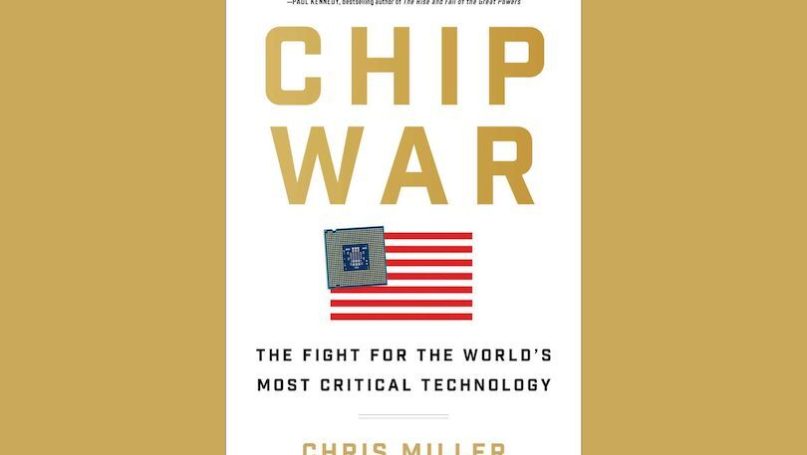
Chip War: The Fight for the World’s Most Critical Technology
By Chris Miller
Simon and Schuster
The adage ‘data is the new oil’ has permeated for several decades; capturing, in a nutshell, the premise that flows of data in an interconnected globalised society bring forth the promise of power and money traditionally generated by hard resources. Whilst oil and data are fundamentally different resources, there is a kernel of truth to the adage; a ‘crude’ indicator would be the morphing of the highest-market value companies in the world, following the turn of the century. By market capitalisation, Saudi Aramco sits alongside Apple, Microsoft, Alphabet and Amazon (Ventura, 2023). However, a focus on data alone would overlook the hard resources that enable data production, storage and flows. Chief among these resources is silicon, the core, crucial ingredient used to produce the semiconductors upon which our computers, automobiles, white appliances, weapons and most modern electronics rely. As early as the 1980s, Jerry Sanders, CEO of AMD compared semiconductors to oil. Chris Miller asks his readers whether Sanders was wrong. Whilst there may be an element of apples and oranges, I personally would be hard-pressed to categorically say such a claim is incorrect.
It is in this context that Chris Miller’s Chip War presents a timely perspective on the formation of an industry that has, arguably, propelled the interconnected world in which we live today. From the research and design of new chips in California, the production of photolithography machines in the Netherlands, to the manufacture of chips themselves; predominantly in Taiwan. Chip War articulately traces the historical development of the semiconductor industry, describes the key personalities, and identifies the core engines that drove the replacement of vacuum tubes with modern semiconductors. These engines, chiefly, appear to be our desire to explore new horizons (i.e., space exploration), to kill one another (or threaten such violence) with greater accuracy (i.e., military sectors), and our pursuit of socioeconomic efficacy (i.e., consumer markets).
Chip War brings the narrative of the rise of the chip(s) to life, threading Cold War geopolitics and post-Cold War dilemmas with the growth of the industry. The industry’s seeding and subsequent bloom seems both serendipitous and inevitable. The market forces were there. The first significant order of chips came from NASA amidst concern that the Soviets were winning the Space Race. But other buyers, whether the Air Force, Texas Instruments or Sony, grasped the significance of semiconductors and saw their utility. Like synapses, researchers, entrepreneurs and vast production lines filled the gap between what was possible and what was desired. In 1972, Carver Mead predicted the placing of tiny computers in telephones, washing machines and cars. As Miller writes, Mead foretold that influence in a digitalising world “would accrue to people who could produce computing power and manipulate it with software” (p.71). By the late 1960s and early 1970s, Intel was producing memory chips with sufficient power that it dawned the possibility of cheaper and more powerful computing by using software-programmed memory chips alongside standardised logic chips. Whilst defence markets had given the chip industry its initial push, the burgeoning weight and promise of the chip ecosystem would, after this point, be carried by consumer markets.
Arguably, interchange between commerce, conflict and chips is more pressing today than ever before. In part this is due to the continued growth of the market. In the second half of 2022, global semiconductor sales reached an all-time high of $574 billion (Casonova, 2023). But more urgently, the resumption of large-scale state-on-state conflict with the Russian invasion of Ukraine and the potential prospect of Chinese direct or indirect attack(s) on Taiwan. With the former, the market restrictions placed on the Russian Federation have brought into sharp light the degree to which effective modern warfare relies on sufficient (in)flows of chips. Russian manufacturers have, purportedly, been stripping semiconductors from goods such as dishwashers and breast pumps in order to use them in weapon systems; although there is a degree of scepticism with such allegations, including from Miller himself (Tegler, 2023). However, Miller’s inclusion of recent conflagration and disruption points includes the SARS-CoV-2 pandemic and the Western furore over Huawei. So, a future edition of, or rejoinder to, Chip War would surely include a chapter on the impact that disrupted chip markets can have on a modern nation-states capacity to wage a modern war.
The spectre of instability in Taiwan is not simply a regional conflict with global military consequences. The economic consequences of such instability would, likely, be dire. Miller estimates that were Taiwan’s semiconductor fabrication plants to be knocked offline, global production of computing power would be 37% less the following year (p.340). It would take at least half a decade to rebuild lost chipmaking capacity. The loss of computing power – and implicated economic loss – prompted by the SARS-CoV-2 pandemic and its associated lockdown strategies could appear as a sniffle compared to the prolonged cold of a protracted conflagration in Taiwan.
I would highly encourage reading Chip War to students interested in the convergence of sociotechnical geopolitics and economics. I would also strongly recommend that policymakers and their researchers heed the warning undertones inherent in the text; if data – and by implication chips – are the new oil, how much disruption in the production of semiconductors should be tolerable? It is, arguably, high-time for a public debate about how the resiliency of these pivotal global markets can be protected.
References
Casanova, R. (2023) “Chip sales rise in 2022, especially to auto, industrial, consumer markets”, Semiconductor Industry Association. Accessed on 22nd April 2023.
Tegler, E. (2023) “Is Russia really buying home appliances to harvest computer chips for Ukraine-bound weapons systems?”, Forbes. Accessed on 22nd April 2023.
Ventura, L. (2023) “World’s largest companies 2023”, Global Finance. Accessed on 22nd April 2023.